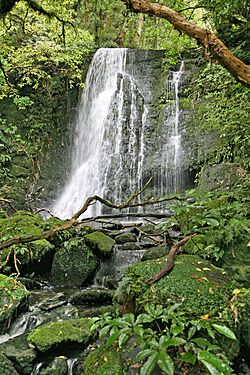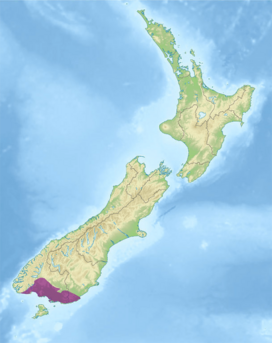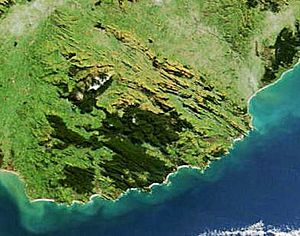Southland temperate forests facts for kids
Quick facts for kids Southland temperate forests |
|
|---|---|

McLean Falls in The Catlins
|
|

Ecoregion territory (in purple)
|
|
| Ecology | |
| Realm | Australasian |
| Biome | temperate broadleaf and mixed forests |
| Borders | Canterbury-Otago tussock grasslands, Fiordland temperate forests, and Southland montane grasslands |
| Geography | |
| Area | 11,603 km2 (4,480 sq mi) |
| Country | New Zealand |
| Regions | Otago and Southland |
| Conservation | |
| Protected | 2,396 km² (21%) |
The Southland temperate forests is a special natural area, or ecoregion, found on New Zealand's South Island. It's a type of forest where trees lose their leaves in winter, but also has evergreen trees. Long ago, this area was mostly covered in forests. However, over many years, people have changed a lot of the original forest into grasslands and farms. This happened because of things like animals eating plants and fires.
Contents
Where are the Southland Forests?
The Southland temperate forests are located at the very bottom part of New Zealand's South Island. To the west, you'll find Fiordland, another unique natural area. The vast South Pacific Ocean is to the south and southeast.
The Takitimu Mountains and Hokonui Hills form the northern edge of this forest region. Other important high areas include the Longwood Range in the southwest and The Catlins in the southeast. The Southland Plains cover the flat, central-southern part of the ecoregion. Invercargill is the biggest city here. Most of this ecoregion is within the Southland Region, but a small part in the northeast is in Otago.
Plants of the Southland Forests
The natural plant life here was mainly forests. These forests had a mix of broadleaf trees and podocarp conifers. Conifers are trees that have needles and cones, like pine trees.
Trees in Higher Areas
In the higher parts of the mountains, you'll mostly find southern beech trees. Two common types are silver beech (Nothofagus menziesii) in the western mountains and red beech (Nothofagus fusca) in the northern mountains.
Trees in Lowland Areas
The forests in the lower areas have many broadleaf trees and podocarps. For example, kahikatea (Dacrycarpus dacrydioides) grows well in wet, swampy places. Rimu (Dacrydium cupressinum) is common in drier spots. You can also find the evergreen broadleaf trees southern rata (Metrosideros umbellata) and kamahi (Weinmannia racemosa) in the central hills and in The Catlins.
Grasslands and Other Habitats
Naturally, there were also areas of tussock grasslands. These grasslands grew much larger where forests were burned or cleared by people. Red tussock grass (Chionochloa rubra) was the main type of grass. Tussocks are clumps of grass. On the higher mountain peaks, you would find snow tussocks (mostly Chionochloa species).
Other natural places in this ecoregion include sand dunes, wet areas near the coast and rivers, and coastal tussock grasslands.
Animals of the Southland Forests
This ecoregion is home to many interesting animals, especially birds and marine mammals.
Native Birds
Some of the native birds you might see include the yellow-eyed penguin (Megadyptes antipodes), which is a unique penguin species. There's also the yellowhead or mōhua (Mohoua ochrocephala), a small, bright yellow bird. The New Zealand rock wren (Xenicus gilviventris) lives in rocky areas. In the tussock grasslands, you can find Swamp harriers (Circus approximans) and South Island fernbirds (Bowdleria punctata punctata).
Marine Mammals
Along the coast, several types of seals and sea lions live. These include Southern elephant seals (Mirounga leonina), New Zealand fur seals (Arctocephalus forsteri), and New Zealand sea lions (Phocarctos hookeri).
History of the Southland Forests
After the last ice age, New Zealand's glaciers melted, and forests grew across the region. Back then, birds were the largest land animals in New Zealand. Several kinds of flightless moa lived here, along with the huge Haast's eagle (Hieraaetus moorei). There were also flightless birds like the New Zealand swan (Cygnus sumnerensis) and the South Island goose (Cnemiornis calcitrans).
Early Human Settlement
The Māori settled in this region after the year 1300. These early settlers hunted birds and seals for food. Sadly, the moa, New Zealand swan, and New Zealand goose were hunted so much that they became extinct. Haast's eagle relied on moas for food, so it also died out when its food source disappeared. Hunters also set fires to clear forests and make it easier to find game. These frequent fires turned large areas of forest into tussock grasslands. As the populations of large birds and seals became smaller, fishing became more important for the local Māori. They set up kaika, or seasonal camps, along the coast.
European Arrival and Changes
European settlers started arriving in the 1800s. Mixed-race whaling bases were set up in places like Port Molyneux, Tautuku, and Waikawa. However, whales were hunted too much, and whaling soon stopped. In the second half of the 1800s, farmers and loggers moved into the region. Sawmilling, which is cutting timber, became an important local business.
The Southland Plains became one of New Zealand's most productive farming areas. Much of the remaining lowland forest was cleared for farms. Many wetlands were also drained or filled in. Large-scale grazing by farm animals and the introduction of new types of grass changed the natural balance of the grasslands.
Protecting the Southland Forests
A lot of the Southland ecoregion has been turned into farmland or pastures. However, over the last few decades, special protected areas have been created. These areas help to save the remaining parts of the upland forests and coastal wetlands. Logging, clearing land for new buildings, and new species of plants and animals brought in by people are still threats to the amazing biodiversity (the variety of life) in this ecoregion.
Protected Areas in Southland

In 2017, it was found that about 2,396 square kilometers, or 21%, of the ecoregion is protected. The Catlins Conservation Park is the largest protected area, covering 528.89 square kilometers. It was created in 1975. Other important protected areas include:
- Takitimu Conservation Area (457.14 km²) in the Takitimu Mountains
- Longwood Forest Stewardship Area (229.55 km²) in the Longwood Range
- Hokonui Forest Stewardship Area (53.68 km²) in the Hokonui Hills
- Seaward Moss Stewardship Area (56.22 km²) on the southern coast

